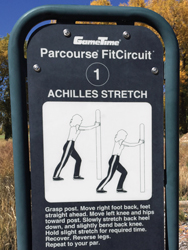If your walk, run or bike ride is becoming routine, try visiting a parcourse, or fitness trail, in your area. Developed in Switzerland in the late 1960s, parcourses feature exercise stations placed near a trail or bike path, or in a public park. Parcourses have been used as part of military fitness training, senior fitness programs and youth physical education. Now you can use them to spice up your workout.
A typical course has 10 to 20 stations, often constructed of steel or wood. Signs instruct you how to use equipment properly and indicate which muscles each station targets. Balance beams, pull-up bars and parallel bars are popular parcourse equipment. At first glance, the set-up may resemble your child’s playground. But don’t be fooled—this workout is for adults.
Parcourses are a good fit for people with bleeding disorders. “The equipment provided covers all the muscle groups,” says Heidi Purrington, PT, a physical therapist at the Hemophilia and Thrombosis Center at Phoenix Children’s Hospital in Arizona. “The trails are in public places, so they are free and easily accessible.”
Tips before you try
Before you hit the circuit, check in with your physical therapist (PT). “Make sure that your joint health and your range of motion will allow you to do the individual exercises,” says Nicole Hroma, PT, senior physical therapist at Lurie Children’s Hospital in Chicago. “If your goal is to work your upper body, your PT can screen your shoulders, elbows and wrists.” Your PT can also confirm that you’re doing the exercises properly.
Some hemophilia treatment centers (HTCs) even offer similar exercise equipment, so you can practice as your PT observes and corrects your form. If your HTC doesn’t have exercise equipment, you can take pictures of each station on your phone and send them to your PT to review.
“Know your limitations and plan which activities are best for you,” advises Purrington. Your PT can also suggest ways to modify difficult exercises so that you can do them safely. Pushups, for instance, can be done standing up with your palms resting against a tree to ease stress on your arms and shoulders.

Nancy Roy
Start slowly. Warm up by walking and stretching for several minutes. Do the same after your workout to cool down. Focus on proper form rather than the number of repetitions. Increase the amount of exercise you do only after you are certain you are doing it right. “When you have good form, work up to doing 10 repetitions, or reps, at an easy pace before you add more reps,” says Hroma.
Vary your focus. Exercise your leg muscles one day, then work your upper body the next time you are out. “Don’t work your whole body all on one day,” Hroma cautions. Limit yourself to three or four exercises each time you go. Plan to hit the parcourse two to three times a week.
A breath of fresh air
Parcourses allow you to escape the monotony of the gym in favor of the outdoors. To make your course even more fun and effective, invite a friend. “A partner’s great for motivation and encouragement,” says Purrington. Your friend can also check your technique, she says. “With guidance from your PT, you can make it work and have fun doing it,” Purrington says.

